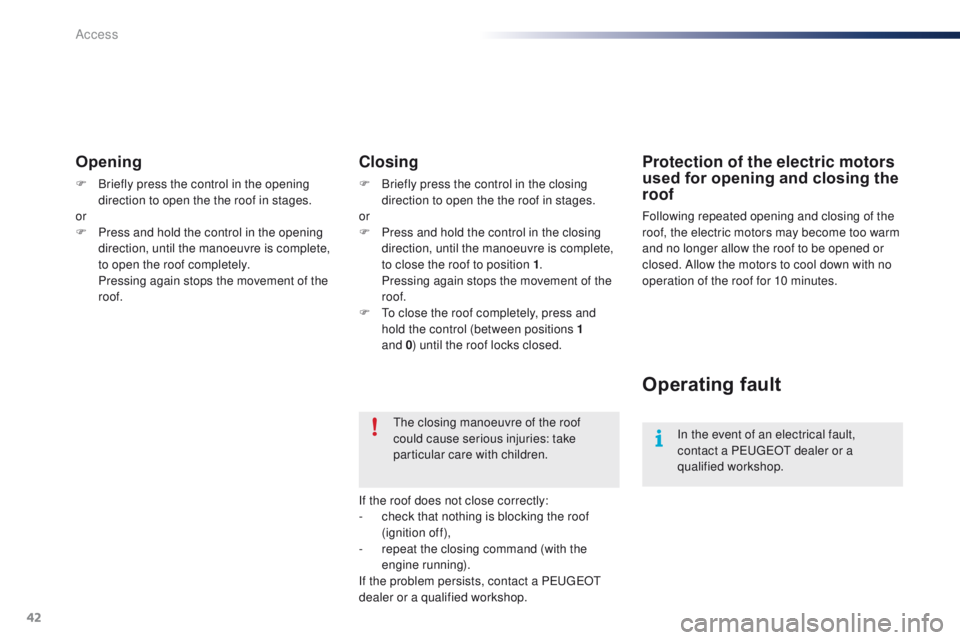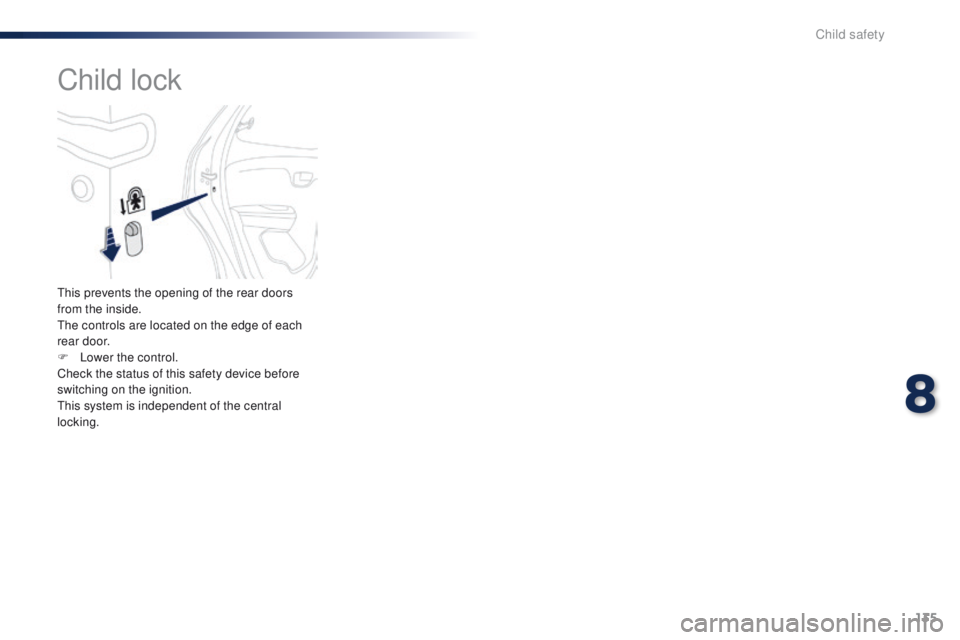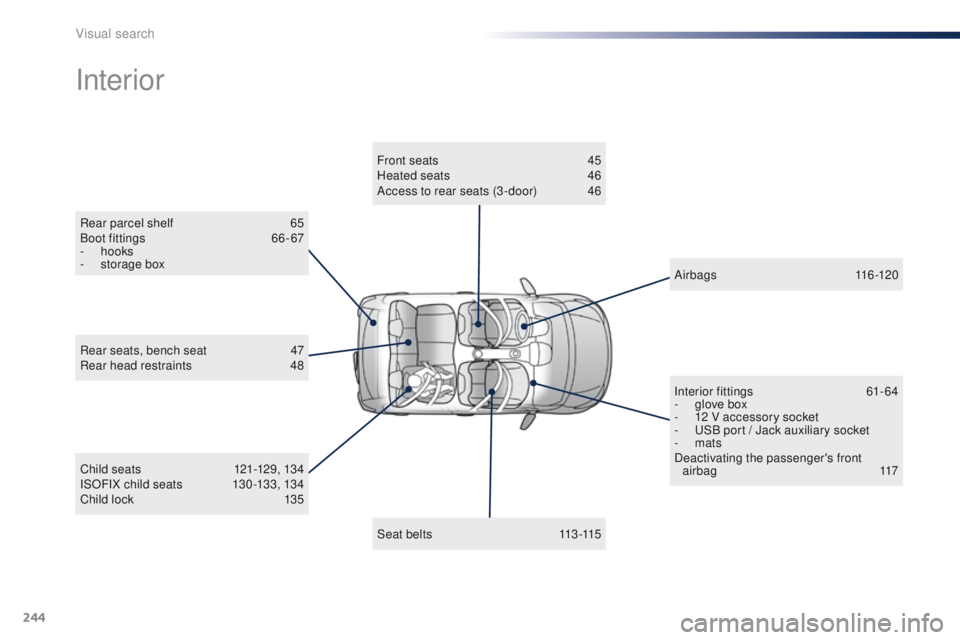2015 PEUGEOT 108 child lock
[x] Cancel search: child lockPage 5 of 271

.
.
108_en_Chap00a_sommaire_ed01-2015
Direction indicators 101
Horn
10
1
Hazard warning lamps
1
02
Under-inflation detection
1
02
e
SC system
1
05
Active City Brake
1
08
Seat belts
1
13
Airbags
116
Safety
Child seats 1 21
Deactivating the passenger's front airbag
1
24
ISOFIX child seats
1
30
Child lock
1
35
Child safety Checks
Fuel tank 1
36
te
mporary puncture repair kit
1
38
Changing a wheel
1
43
Snow chains
1
48
Changing a bulb
1
49
Changing a fuse
1
54
12 V battery
1
63
el
ectrical energy economy mode
1
66
Changing a wiper blade
1
66
to
wing the vehicle
1
67
Fitting roof bars
1
68
Accessories
169
Practical informationte chnical data
7-inch touch screen 183
Radio 223
Audio equipment and telematics
Visual search
Alphabetical index
B o n n et 17 2
Petrol engines
1
73
Checking levels
1
74
C h e c ks
17 7
en
gines
1
79
Weights
180
Dimensions
1
81
Identification markings
1
82
Contents
Page 38 of 271

36
108_en_Chap02_ouvertures_ed01-2015
Changing the battery of
the electronic key
Battery ref.: CR2032 / 3 volts.When replacement of the battery is
needed, this warning lamp comes on
in the instrument panel.
F
u
n
clip the cover using a small screwdriver
at the cutout.
F
R
emove the cover.
F
R
emove the protective battery holder,
pulling it upwards.
F
R
emove the discharged battery from its
housing.
F
F
it the new battery into its housing
observing the original direction of fitment.
F
R
efit the battery holder.
F
C
lip the cover onto the casing.
Lost keys
go to a PeugeOt dealer with the vehicle's registration document, your personal
identification documents and if possible the key code label.
th
e P
e
uge
Ot
dealer will be able to look up the key code and the transponder code
required to order a new key.
Remote control / Electronic key
these high frequency devices are sensitive systems; do not handle them while in your
pocket as there is a risk of unlocking the vehicle, without you being aware of it.
Do not repeatedly press the buttons of your remote control or electronic key out of range
and out of sight of your vehicle. You run the risk of stopping it from working and the remote
control would have to be reinitialised.
Locking the vehicle
As a safety precaution, never leave children alone in the vehicle, except for a very short
period.
In all cases, it is essential to remove the key from the ignition switch, or take the electronic
key with you when leaving the vehicle.
When purchasing a second-hand vehicle
Have the pairing of all of the keys in your possession checked by a Pe ugeOt dealer, to
ensure that only your keys can be used to open and start the vehicle.
Access
Page 44 of 271

42
108_en_Chap02_ouvertures_ed01-2015
Opening
F Briefly press the control in the opening direction to open the the roof in stages.
or
F
P
ress and hold the control in the opening
direction, until the manoeuvre is complete,
to open the roof completely.
P
ressing again stops the movement of the
roof.
Closing
F Briefly press the control in the closing direction to open the the roof in stages.
or
F
P
ress and hold the control in the closing
direction, until the manoeuvre is complete,
to close the roof to position 1 .
P
ressing again stops the movement of the
roof.
F
t
o c
lose the roof completely, press and
hold the control (between positions 1
and
0) until the roof locks closed.
th
e closing manoeuvre of the roof
could cause serious injuries: take
particular care with children.
If the roof does not close correctly:
-
c
heck that nothing is blocking the roof
(ignition off),
-
r
epeat the closing command (with the
engine running).
If the problem persists, contact a P
e
uge
Ot
dealer or a qualified workshop.
Operating fault
In the event of an electrical fault,
contact a Pe ugeOt dealer or a
qualified workshop.
Protection of the electric motors
used for opening and closing the
roof
Following repeated opening and closing of the
roof, the electric motors may become too warm
and no longer allow the roof to be opened or
closed. Allow the motors to cool down with no
operation of the roof for 10 minutes.
Access
Page 117 of 271

115
108_en_Chap07_securite_ed01-2015
the driver must ensure that passengers use
the seat belts correctly and that they are all
restrained securely before setting off.
Wherever you are seated in the vehicle,
always fasten your seat belt, even for short
journeys.
Do not interchange the seat belt buckles as
they will not fulfil their role fully.
th
e seat belts are fitted with an inertia reel
permitting automatic adjustment of the
length of the strap to your size.
t
h
e seat belt
is stowed automatically when not in use.
Before and after use, ensure that the seat
belt is reeled in correctly.
th
e lower part of the strap must be
positioned as low as possible on the pelvis.
th
e upper part must be positioned in the
hollow of the shoulder.
th
e inertia reels are fitted with an automatic
locking device which comes into operation in
the event of a collision, emergency braking
or if the vehicle rolls over. You can release
the device by pulling the strap firmly and
then releasing it so that it reels in slightly.Recommendations for children
use a suitable child seat if the passenger is
less than 12 years old or shorter than one
and a half metres.
Never use the same seat belt to secure more
than one person.
Never allow a child to travel on your lap.
For more information, refer to the "Child
seats" section.
In order to be effective, a seat belt must:
-
b
e tightened as close to the body as
possible,
-
b
e pulled in front of you with a smooth
movement, checking that it does not
twist,
-
b
e used to restrain only one person,
-
n
ot bear any trace of cuts or fraying,
-
n
ot be converted or modified to avoid
affecting its performance.
In the event of an impact
Depending on the nature and
seriousness of the impact , the
pretensioning device may be deployed
before and independently of the airbags.
Deployment of the pretensioners is
accompanied by a slight discharge of
harmless smoke and a noise, due to the
activation of the pyrotechnic cartridge
incorporated in the system.
In all cases, the airbag warning lamp
comes
on.
Following an impact, have the seat belts
system checked, and if necessary replaced,
by a P
e
uge
Ot
dealer or a qualified
workshop.
In accordance with current safety
regulations, for all repairs on your vehicle's
seat belts, go to a qualified workshop with
the skills and equipment needed, which a
Pe
ugeOt d
ealer is able to provide.
Have your seat belts checked regularly by a
P
e
uge
Ot
dealer or a qualified workshop,
particularly if the straps show signs of
damage.
Clean the seat belt straps with soapy
water or a textile cleaning product, sold by
P
e
uge
Ot d
ealers.
After folding or moving a seat or rear bench
seat, ensure that the seat belt is positioned
and reeled in correctly.
7
Safety
Page 136 of 271

134
108_en_Chap08_securite-enfants_ed01-2015
the incorrect installation of a child seat in a
vehicle compromises the child's protection in
the event of an accident.
Check that there is no seat belt or seat belt
buckle under the child seat as this could
destabilise it.
Remember to fasten the seat belts or the
child seat harnesses keeping the slack in
relation to the child's body to a minimum,
even for short journeys.
For the installation of a child seat using a
seat belt, ensure that this is well tensioned
on the child seat and that it is holding the
child seat firmly against the seat of your
vehicle. If your front passenger seat is
adjustable, move it forward if necessary.
At the rear seats, always leave sufficient
space between the front seat and:
-
a r
ear ward facing child seat,
-
t
he feet of a child seated in a for ward
facing child seat.
For this, move the front seat for ward and if
necessary straighten its backrest.
Recommendations on child seats
the chest part of the seat belt must be
positioned on the child's shoulder without
touching the neck.
en
sure that the lap part of the seat belt
passes correctly over the child's thighs.
P
e
uge
Ot
recommends the use of a booster
seat which has a back, fitted with a seat belt
guide at shoulder level.
As a safety precaution, never leave:
-
o
ne or more children alone and
unsupervised in a vehicle,
-
a c
hild or an animal in a vehicle which
is exposed to the sun, with the windows
closed,
-
t
he keys within reach of children inside
the vehicle.
to p
revent accidental opening of the doors,
use the "Child lock".
ta
ke care not to open the rear windows by
more than one third.
to p
rotect young children from the rays of
the sun, fit side blinds on the rear windows.
th
e legislation on carrying a child on the
front passenger seat is specific to each
country. Refer to the legislation in force in
your country.
Deactivate the passenger's front airbag
when a rear ward facing child seat is installed
on the front seat. Otherwise, the child would
risk being seriously injured or killed if the
airbag were deployed. For optimum installation of the forward facing
child seat, ensure that the back of the child
seat is as close as possible to the backrest
of the vehicle's seat, or in contact if possible.
th
e head restraint must be removed before
installing a child seat with a backrest on the
passenger seat.
en
sure that the head restraint is stowed or
attached securely so that it is not thrown
around the vehicle in the event of sharp
braking.
Refit the head restraint as soon as the child
seat is removed.
Installing a booster
cushion
Children at the front
Child safety
Page 137 of 271

135
108_en_Chap08_securite-enfants_ed01-2015
Child lock
this prevents the opening of the rear doors
from the inside.
th
e controls are located on the edge of each
rear door.
F
L
ower the control.
Check the status of this safety device before
switching on the ignition.
th
is system is independent of the central
locking.
8
Child safety
Page 246 of 271

244
108_en_Chap13_recherche-visuelle_ed01-2015
Rear parcel shelf 65
Boot fittings 6 6 - 67
-
hooks
-
s
torage box
Interior
Child seats 1 21-129, 134
ISOFIX child seats 1 30 -133, 134
Child lock
1
35
Rear seats, bench seat
4
7
Rear head restraints
4
8
Interior fittings
6
1-64
-
g
love box
-
1
2 V accessory socket
- u
S
B port / Jack auxiliary socket
- mats
Deactivating the passenger's front airbag 117
Airbags
116-120
Seat belts
1
13-115
Front seats
4
5
Heated seats
4
6
Access to rear seats (3 -door)
4
6
Visual search
Page 250 of 271

248
108_en_Chap14_index-alpha_ed01-2015
ABS .......................................................105, 10 6
Accessories .................................................. 169
Accessory socket, 12V
.............................61, 62
Access to rear seats (3 -door)
.........................46
Active City Brake
.................................... 1
0 8 -112
Adjusting headlamps
...................................... 98
Adjusting the steering wheel
..........................50
Advice on driving
............................................ 68
Airbags
..................................................... 17, 11 6
Airbags, curtain
..................................... 11
9 , 12 0
Airbags, front .......................................... 117, 1 2 0
Airbags, lateral
...................................... 118, 120
Air conditioning
..................................... 8, 55, 58
Air conditioning, automatic
.............................56
Air conditioning, manual
.................................54
Air distribution adjustment
.................53, 54, 57
Air filter
.......................................................... 17 7
Air flow adjustment
............................53, 54, 57
Air intake
................................................... 55-57
Air recirculation
......................................... 55, 57
Air vents
.......................................................... 51
Anti-lock braking system (ABS)
............105, 10 6
Audible warning
............................................ 101
Audio cable
........................................... 19 6, 233
Audio streaming (Bluetooth)
................. 19
9, 23 4
Audio system
................................................. 223
Automatic illumination of headlamps
........94, 96
Auxiliary
......................................... 63, 196, 233Capacity, fuel tank
..............................
..........13 6
Central locking
..........................................31, 3 4
Changing a bulb
.....................................14 9 -15 3
Changing a fuse
.....................................15 4 -16 2
Changing a wheel
..................................143 -147
Changing a wiper blade
................................166
Changing the electronic key battery
...............36
Changing the remote control battery
..............32
Changing the time
.....................................28, 29
Checking levels
...................................... 17
4 -176
Checking tyre pressures (using the kit)
..............................
................141
Checks
...............
....................................173 -178
Child lock
...............................
........................13 5
Children
...............................
....115 , 117, 12 1 -13 5
Child seats
.....................12
1-123, 127, 131, 13 4
Child seats, conventional
..............................127
Child seats, ISOFIX
...............................13
1-13 3
Closing the boot
..............................................38
Closing the doors
............................................34
Clutch
............................................................17 7
Colour screen
...............................
.................183
A
C
Connectors, audio .......................... 6 3, 196, 233
Coolant level ................................................. 176
Cup holder
...............................
........................61
Battery, remote control ...................................
32
B
luetooth (hands-free) .......................... 20
2, 235
Bluetooth (telephone)
............................ 202, 235
Bonnet
........................................................... 172
Boot
................................................................. 38
Boot lamp
........................................................ 98
Brake discs
.................................................... 17
8
Brake lamps
...............................
................... 152
Brake pads
.................................................... 178
Battery
............................................ 163 -165, 177
Battery, charging
........................................... 165
Battery for electronic key
................................ 36
ea
sy mode (automatic mode) .........................75
eBA
(
em
ergency braking
assistance)
.................................................. 105
BE
DAB (Digital Audio Broadcasting) ........19 4, 231
Daytime running lamps ...................................94
Deactivating the passenger airbag
...............117
Demisting/defrosting front
.............................. 59
D
emisting, defrosting, rear
............................. 60
D
igital Audio Broadcasting (DAB)
........ 1
9 4, 231
Dimensions
................................................... 181
Dipped beam
...............................
............93, 150
Dipstick
................
.......................................... 174
Direction indicators
.......................101, 150, 152
Display screen
.................................... 12, 13, 25
Doors
............................................................... 37
Door pockets
................................................... 61
D
riving economically ........................................ 8
Driving mode
................................................... 75
Dynamic stability control (DSC)
...................................... 16, 23 , 105 -107
D
Alphabetical index